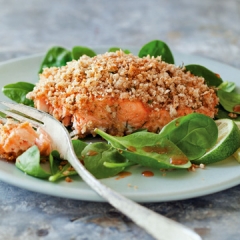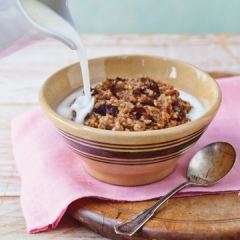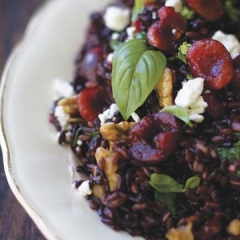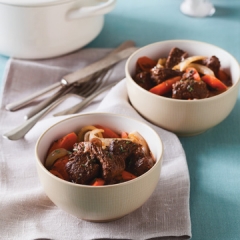How To Slim Down Your Diet
We may receive a commission on purchases made from links.
Wanting to be healthier and actually making that change are two very different things. As Tosca Reno, author of the best-selling Eat Clean Diet says, "You have to give yourself permission to change." And that's when it will really happen.
But, it's not going to happen just by wishing it, you've got to take the small (and big steps) toward making yourself the way you want to be. Luckily, Reno, someone who has successfully made and maintained the change, shared some of her starting tips with us. She recently published The Eat-Clean Diet Cookbook 2, which includes many of her recipes and tips that are aimed at success.
Follow her tips and advice listed below to learn how to slim down your diet and eating habits, just by making a few small changes here and there. Even if you just pick one and stick to it, well, then you're better off than when you started.
Find the Sugar in Your Diet
The very first thing to do when looking to slim down is to address where the sugar is in your diet. Sugar isn't just what you're putting in your coffee; it's also present in carbohydrates such as cereal, pastries, cookies, bread, and, the obvious, sugar-laden beverages, sports drinks, and even juices. So understanding where this excess sugar comes from and limiting it can be a very powerful change in how you feel. If you replace a sports drink with water once a day, you'll be surprised at how good you feel.
The first thing I do before I put food in my mouth is to start the day with a glass of water, at least eight ounces. After you've slept for however many hours, your body is very thirsty — to get everything opened up and working properly it needs water first. I like to put a little spritz of lemon in the water to clean the pipes out and get the bowels moving.
The next thing your body needs is a complex carbohydrate and lean protein. For my way of thinking, that's hard-boiled eggs and oatmeal. Lately, I've moved to a nut and seed mixture: Two tablespoons flaxseed, hempseed, and wheat germ in a bowl and mix that with applesauce, plain yogurt, or berries. You've got your healthy fat there, protein, fiber, and omega 3s, and it's a really great way to start the day. And that nutrient amount in the dish is very sufficient and will keep you feeling very satisfied for three to four hours.
Click here to see the Oat Porridge recipe.
Opt for Salads Over Side Dishes
One of the most powerful ways to change your diet really doesn't start with cutting back so much as replacing. So, if you were planning on having a greasy side dish for your main course to accompany a piece of salmon, replace it with a salad instead. Then, it doesn't feel so much like you're dieting; it just means you are choosing a replacement strategy to get something healthy in you. It still nourishes and satisfies. If you live in a colder climate and don't want to do a salad, try to get some cooked kale, spinach, or Swiss chard. These are wonderful strategies to get extra fiber and immune-boosting nutrients in you.
Reinvent Your Idea of a Salad
I think that salads are great; we have to reinvent our idea of a salad because you can make a salad out of cooked greens as well as out of quinoa, which is currently my favorite food. Salads are definitely the traditional health food, but as long as you keep your salad clean by dressing it with citrus juice — orange, lemon, or lime — and a good oil, you should be fine experimenting.
If you don't want a salad, you can do an open-faced sandwich, with sprouted-grain bread (good for gluten-intolerant people) and you can still put some greens — spinach or romaine — sliced tomato, or a piece of grilled salmon or chicken on it with a little salt and pepper or mustard.
Try Flavorful and Healthy Soups and Stews
Make sure that whatever cooking liquids you are using to create the soup base are not loaded with too many saturated or trans fats. It all begins by creating that delicious base to make your creamy stew. I always put a mixture of olive oil and coconut oil in a Dutch oven. Coconut oil has six grams of fat per tablespoon while others have nine grams per tablespoon; it is very heart-healthy with many anti-viral properties.
Then, I create a flavor base and sauté a mixture of carrots, parsnips, onions, garlic, and celery and make that into a very soft vegetable based mixture. I add a bit of the cooking liquid to that mixture and then purée it, and that's my sauce. Next I'll add the grains, beef, or whatever. It doesn't have to be heavy and has a healthier, more nutrient-filled base.
 Ways to Add Flavor Without Fat
Ways to Add Flavor Without Fat
The biggest way to add flavor without fat is with herbs, whether fresh or dried. There are such an abundance of spices and herbs to cook with that it's really easy to get creative with any combination of them. For my turkey, I go crazy using turmeric, poultry spices, paprika, dill, or thyme. I also roast several bulbs of garlic until it becomes so soft and mushy that you can cut it into butter, so that your butter is half garlic half butter — you can cut down on fat right there or use it as a spread itself.
Salt doesn't add fat, but it can be a bit of a tricky ingredient because so many of the nutrients have been refined out, so I encourage people to season their foods with unrefined sea salt in order to add flavor without fat.
Using things like vinegars or molasses, any sort of fermented foods, green tea, or lavender tea adds a richness to food. For baking, you can also use puréed fruits to add flavor or even puréed squashes and sweet potatoes because they have a sweetness of their own. Simply add cinnamon or cloves or allspice — or pumpkin is fantastic for that, too.
Click here to see the Crunchy Baked Ginger-Dill Salmon recipe.
Tasty Pasta Alternatives
There are a couple of ways you can still enjoy pasta while being healthier — stick with whole grains, brown rice, or spelt pasta. I've also found a machine called a Spirooli that you can use to almost create your own pasta with zucchini or other vegetables. They almost look like noodles and you can steam them, eat them raw, or top them with tomato sauce or garlic and olive oil. Zucchini is great because all you have to do is give it a little heat in a sauté pan with some olive oil and it takes on flavor so quickly. Throw some marinara sauce on top and you're good to go.
Quinoa is one of my favorites because you can make it sweet or savory or grind it into a flour. I like brown rice for people who have issues with digesting gluten because brown rice is gluten-free and is good for you. Buckwheat, millet, and some more traditional wheat are alright, but you have to watch the gluten intolerance. You can help yourself by pre-soaking your grains — if you do it for a couple of hours, it helps to soften up the coating on the outside of the grain and takes less time to cook, creating— less issues in your stomach.
During the holidays we think quite a bit of turkey, but most of the year we ignore it, so try to think of turkey as an excellent option for lean protein throughout the year. You can buy the breast and thigh meat separately, making it very versitile. Alternatively, you can buy white fishes, which tend to be less fatty than a fish like salmon. Even though we want to watch calories, fatty fish is good for you because on a daily basis, you should be eating 30 percent fat, 40 percent protein, and 30 percent complex carbohydrates.
Click here to see the Venison Bourguignon recipe.
Small Changes Can Make a Big Difference
The easiest approach is to try to not bite off more than you can chew. If you really want to make some changes but it feels overwhelming, ask yourself, what's a 5 percent change that I can make in my way of eating to make it better? If that means, I'm going to eat a salad once a day, that's a 5 percent change and that's do-able. For someone else, it could be incorporating breakfast into their diet if they usually skip it.


